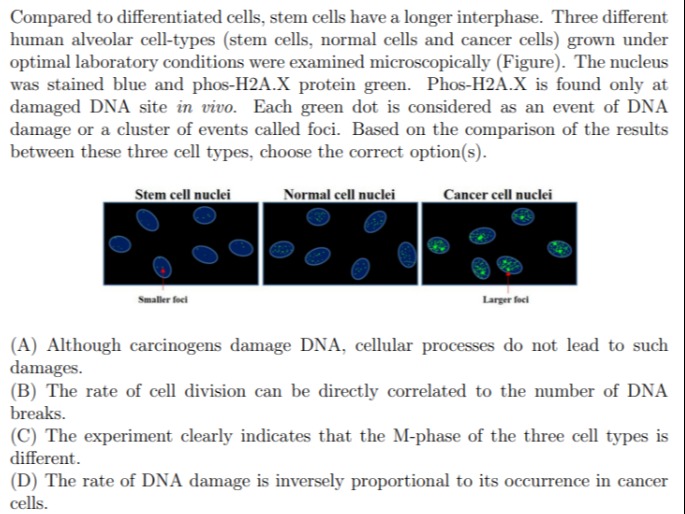Question
Question: Compared to differentiated cells, stem cells have a longer interphase. Three different human alveola...
Compared to differentiated cells, stem cells have a longer interphase. Three different human alveolar cell-types (stem cells, normal cells and cancer cells) grown under optimal laboratory conditions were examined microscopically (Figure). The nucleus was stained blue and phos-H2A.X protein green. Phos-H2A.X is found only at damaged DNA site in vivo. Each green dot is considered as an event of DNA damage or a cluster of events called foci. Based on the comparison of the results between these three cell types, choose the correct option(s).

Although carcinogens damage DNA, cellular processes do not lead to such damages.
The rate of cell division can be directly correlated to the number of DNA breaks.
The experiment clearly indicates that the M-phase of the three cell types is different.
The rate of DNA damage is inversely proportional to its occurrence in cancer cells.
B
Solution
The problem describes an experiment comparing DNA damage in stem cells, normal cells, and cancer cells using phos-H2A.X protein as a marker for DNA damage foci (green dots). The nucleus is stained blue. We need to analyze the figure and the provided information to select the correct option(s).
Analysis of the Figure and Given Information:
- Stem cell nuclei: Show very few and small green foci, indicating minimal DNA damage. The text also states that stem cells have a longer interphase compared to differentiated cells, implying a potentially slower division rate (though they are proliferative).
- Normal cell nuclei: Show more green foci than stem cells, but fewer and smaller than cancer cells, indicating some baseline DNA damage. Normal cells divide at a controlled rate.
- Cancer cell nuclei: Show a significantly higher number of green foci, and these foci are larger, indicating extensive DNA damage. Cancer cells are characterized by rapid and uncontrolled cell division.
Evaluation of Options:
-
(A) Although carcinogens damage DNA, cellular processes do not lead to such damages.
- This statement is incorrect. DNA damage can occur from both external factors (like carcinogens) and internal cellular processes (e.g., replication errors, metabolic byproducts, spontaneous hydrolysis). The presence of some DNA damage in normal cells, even under optimal laboratory conditions, suggests that cellular processes contribute to DNA damage.
-
(B) The rate of cell division can be directly correlated to the number of DNA breaks.
- Let's compare the observations:
- Stem cells: Relatively slower division (longer interphase) and very few DNA breaks.
- Normal cells: Moderate division rate and moderate DNA breaks.
- Cancer cells: Very rapid and uncontrolled division, and a very high number of DNA breaks.
- This shows a clear direct correlation: as the rate of cell division increases, the number of DNA breaks (damage) also increases. Rapid DNA replication in fast-dividing cells, especially cancer cells, can lead to replication stress and increased DNA damage.
- Let's compare the observations:
-
(C) The experiment clearly indicates that the M-phase of the three cell types is different.
- The experiment primarily focuses on DNA damage, which is assessed during interphase (where DNA replication and repair occur). While DNA damage can affect M-phase progression, the figure and the description do not provide direct information or measurements about the duration or characteristics of the M-phase itself for these cell types. Therefore, we cannot conclude this from the given data.
-
(D) The rate of DNA damage is inversely proportional to its occurrence in cancer cells.
- "Occurrence" refers to the observed amount of DNA damage. The figure shows a high occurrence of DNA damage in cancer cells. If the rate of DNA damage were inversely proportional to its occurrence, it would mean that a high occurrence implies a low rate of damage, which is contradictory. A high occurrence of damage suggests a high rate of damage or an accumulation of damage due to impaired repair mechanisms, implying a direct relationship between rate and occurrence (or accumulation), not an inverse one.
Based on the analysis, option (B) is the only correct statement.
